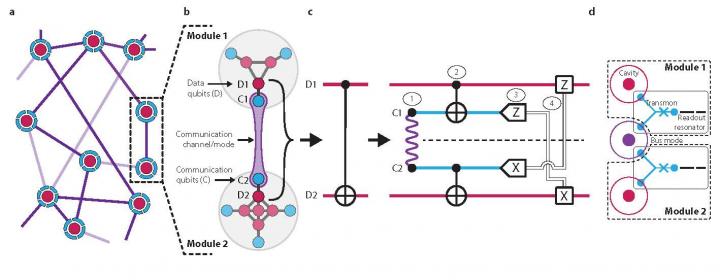
Quantum Gate Teleportation Could Be Used in Modular Approach to Quantum Architecture
NEW HAVEN, Conn., Sept. 6, 2018 — Yale University researchers have demonstrated the on-demand teleportation of a quantum gate between two qubits, an advance that could be useful in a modular approach to building quantum computers. Quantum teleportation is the nonphysical transport of quantum states between two parties.
One approach to constructing a large-scale quantum processor is to utilize modularity. A quantum modular architecture consists of a collection of modules that functions as small quantum processors connected into a large network. In a modular architecture, a necessary capability for universal quantum computation would be the teleportation of an entangling quantum gate. Teleported gates provide a way to implement intermodule operations.

An overview of the network of modular quantum architecture demonstrated in the new study. Courtesy of Yale University.
The researchers experimentally demonstrated the teleportation of a controlled-NOT (CNOT) gate, which they made deterministic by using real-time adaptive control. They activated the gate between two logical qubits, encoding quantum information redundantly. By using an error-correctable encoding approach, the researches achieved a process fidelity of 79 percent with their teleported gate.
“Our work is the first time that this protocol has been demonstrated where the classical communication occurs in real time, allowing us to implement a ‘deterministic’ operation that performs the desired operation every time,” researcher Kevin Chou said.
“Our experiment is also the first demonstration of a two-qubit operation between logical qubits,” professor Robert Schoelkopf said. “It is a milestone toward quantum information processing using error-correctable qubits.”
The research was published in Nature (doi: 10.1038/s41586-018-0470-y).
Published: September 2018